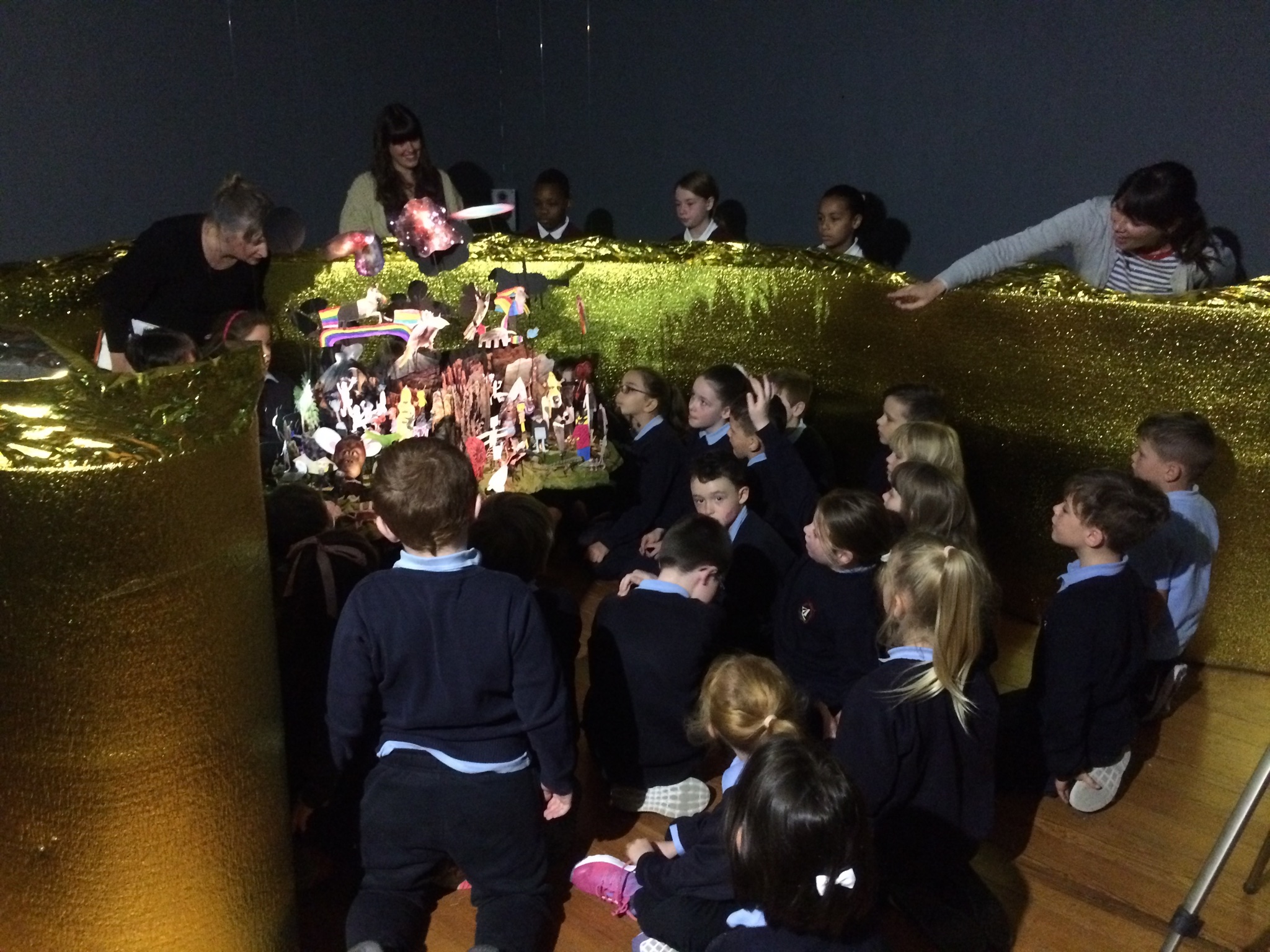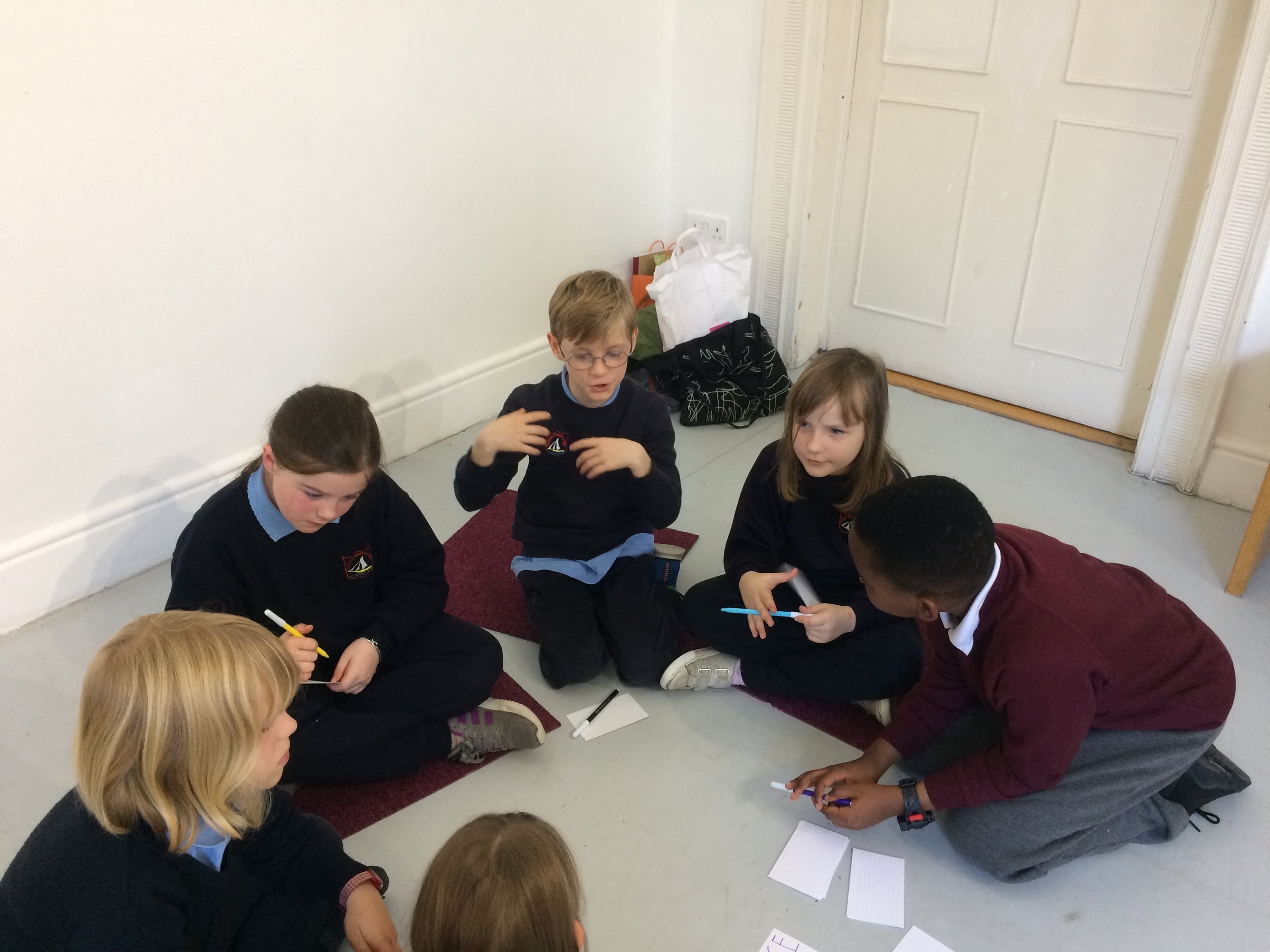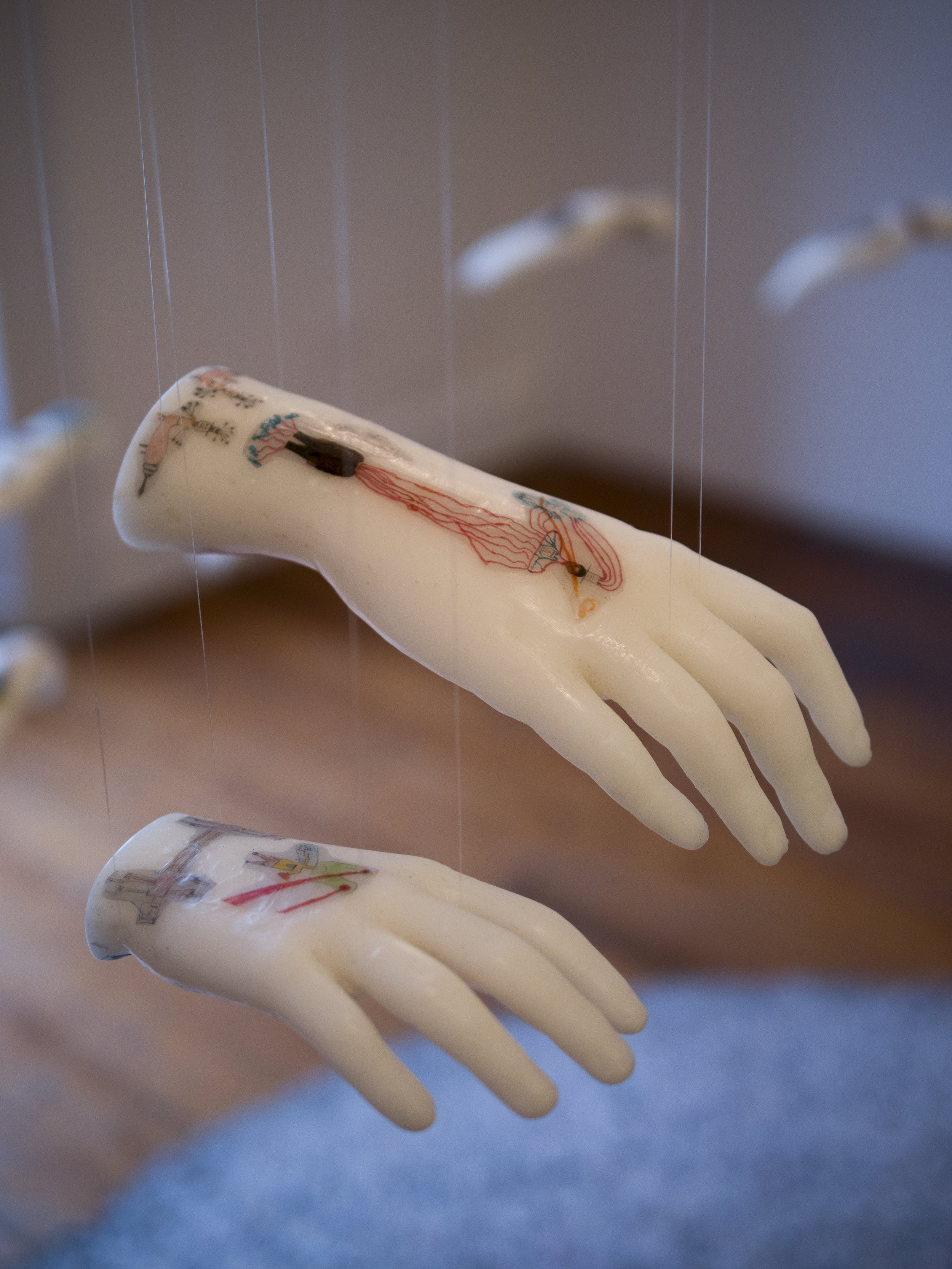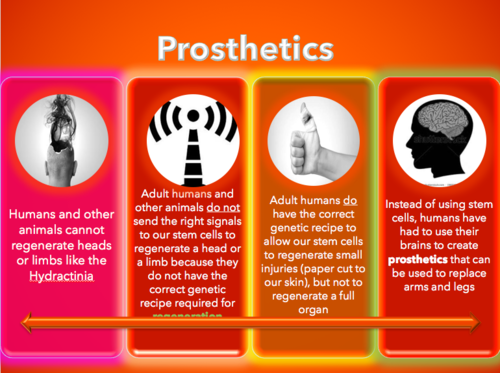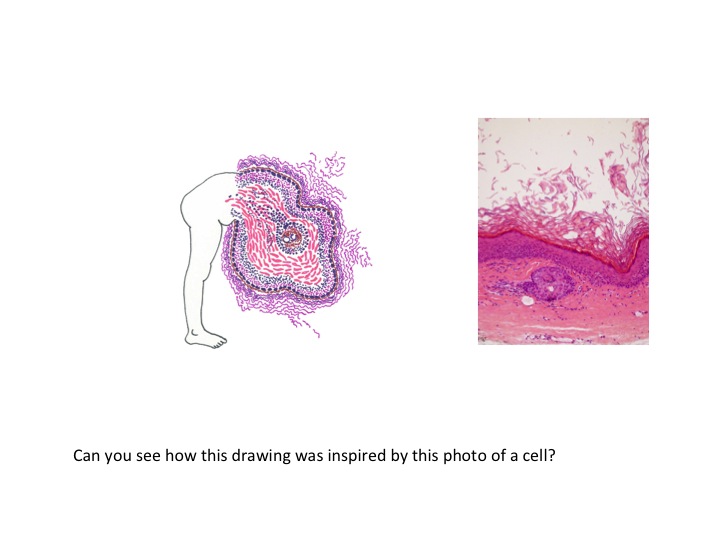Human Being and Human Becoming is a collaborative commission with artist Siobhan McGibbon and third class children from Scoil Chroí Íosa, exploring imaginative future possibilities for the human body, in partnership with with Galway Arts Centre and Baboró International Arts Festival for Children. Working over 9 sessions, Siobhan and the students have used collage and sculpture to explore these transhuman themes, resulting in an exhibition (15th-27th October 2018) in Galway Arts Centre for Baboró International Arts Festival for Children.
Siobhan McGibbon’s practice combines arts practice, narrative and scientific research to imagine the future of the human species. In 2015 she created the world of the Xenothorpeans, a hybrid race of post-humans who were able to enhance their anatomy and genetic make-up with medical therapies. This fictional narrative evolved from research undertaken by her whilst on residency in the Centre for Research in Medical Devices (CÚRAM). Through the development of hybrid figures she articulates her hopes and fears concerning medical technology and the future of the human.
With this in mind, Siobhan has worked collaboratively with the pupils from Scoil Chroí to develop a speculative science fiction. This project has immersed the pupils within the realms of their own science fiction, enabling them to create their own hypothetical future hybrids inspired by science fact...
A further element to the project was The Art & Philosophy programme with education curator Katy Fitzpatrick and professor in the philosophy of education Aislinn O’Donnell. Aislinn and Katy worked with Siobhan and some of the students from Scoil Chroí Íosa to facilitate 2nd and 5th Class students from another school - Claddagh NS to undertake a critical and creative enquiry of the thoughts and ideas prompted by the artworks.
"Is it real? No, it is not real. What is this not real? Not real can tell us about real."
Margaret Atwood (2009) Oryx and Crake
Human Being and Human Becoming is funded by The Arts Council.
....
FILM
Film features interviews with Siobhan McGibbon, some students and teacher Rachel Scott; as well as documentation of the Art & Philosophy project happening in Galway Arts Centre. Videography by Louise Manifold.
….
PROJECT DIARY
ART & PHILOSOPHY WITH AISLINN O’DONNELL AND KATY FITZPATRICK
18th-19th October
Education Curator Katy Fitzpatrick and Professor in the Philosophy of Education Aislinn O’Donnell brought their exciting Art & Philosophy programme to the exhibition Human Being and Human Becoming at Galway Arts Centre.
For the Art & Philosophy programme, Aislinn and Katy joined Siobhan and children from Scoil Chroí Íosa to work with 2nd and 5th Class students from another local Galway school - Claddagh NS. The Art & Philosophy programme ‘introduces students and their teachers to both philosophical enquiry and contemporary art practice. Centred on the voice, ideas, experiences, and imagination of children, it aims to cultivate and support their aesthetic responses, their imaginations, and their desire and curiosity to explore big questions about identity, becoming and what it means to be human.’
The artwork in the exhibition and the Art & Philosophy programme together provided participating students with an enquiring and fun platform to think about the future, the nature of existence, bio-technology, the body, art and more…
#bigquestions #prolongedlooking #art+philosophy #art+philosophy+science
THE EXHIBITION AT GALWAY ARTS CENTRE
15-27th October
The exhibition included the resulting amazing sculptural, audio and collage work by artist Siobhan McGibbon and her fellow artists from Scoil Chroí Íosa…
The exhibition programme also included workshop for children ‘Anatomies of Imagination’ with Siobhan McGibbon.
#creatingsciencefiction #artbychildrenforchildren #speculativefutures
SCIENCE FICTION AUDIO
5th & 6th June
With microphones, pop shields and recording devices as their tools; Siobhan led the students in the creation of audio pieces using storytelling and sounds effects to continue to explore the multifaceted types of cellular regeneration in the animal kingdom, this time with newts as key protagonists. Stories were developed and shared, and recording began in the first session. The class considered how an audio recording for an exhibition differs from presenting to the classroom since the audience might not be able to see the image, and so the students took care to introduce the characters and use more descriptive language. In the second session, recording continued and the addition of sound effects was made, with the aim of creating a more immersive audience experience.
#storytelling #imaginingtheaudience #imaginingotherlifeforms
IMMORTALITY!
30th May
“It's kind of like a butterfly that instead of dying changes back to a caterpillar, or an aged chicken turning back into an egg.”
Dr Karl Kruszelnicki
In this session, Siobhan and the students opened the moulds to reveal the wax hands. Siobhan showed the students a presentation about immortality and talked about how her work is inspired by this subject. Together they discussed the consequences of living forever... Following this, Siobhan introduced the class to immortal jellyfish, and talked about how the animal regenerates and the strange life it leads. Siobhan then set the students the task of creating their own immortal jellyfish narrative, encouraging the students to combine the real science they have learnt in these sessions with hypothetical scenarios exploring the consequences of immortality.
#strangecreaturesofthedeep #liveforever #roomontheplanet
WORKING WITH MOULDING AND CASTING
29th May
In this session, Siobhan helped the students make moulds of their arms, using alginate. Inspired by Siobhan’s artwork “The symbols of my awakening”, based on the African Clawed Toad, as well as the scientist's previous presentation on the ability of newts to regenerate limbs, the students created their own newt/human hybrids. Siobhan showed the students how to insert their hands into the alginate without touching the sides of the container and how to comfortably position themselves so they can hold the pose. Each student created a alginate mould. They learnt how to mix the material and watched the material change from pink to white as it cured. Upon curing, the students opened the mould, resealed them and poured the wax with Siobhan’s help. Students also created mixed media images of hybrid humans by combining cut-outs of themselves with cut-outs of animals. In these sci-fi scenarios Siobhan asked the students to place themselves in the narrative and think about how their lives would improve with the animals' biological attributes. These drawings will become tattoos on their future human limbs.
#creatinglimbs #animalpowers #tattoostellingstories
WHAT SEA STARS CAN TEACH US
22nd May
In this session, Siobhan began the class by opening the alginate mold created in the previous session. The students were amazed by the detail of the cast and excited about next week’s workshop. Siobhan then spoke to the class about the Sea Star, another animal that the scientist had talked about in last week’s session. Siobhan showed the class a presentation of unusual facts about these sea creatures; such as their symmetry, their five eyes or how they push their stomachs outside their bodies to eat their food. They imagined what it would be like for humans to have these capabilities and created storyboards which they discussed as a group. Siobhan gave each student a fragmented cut out of an animal and asked each student to re-design the creature, taking inspiration from what they had learnt about how stem cells work from Dr Sarah Grundy's talk the previous week.
#imagininglifeforotheranimals #stemcells #hybridity
...
CELL REGENERATION AND THE AMAZING HYDRACTINIA ECHINATA
21st May
In this session, Siobhan spoke to the class about the amazing regenerative capacities of the hydractinia echinata - a microscopic sea creature that the scientist had introduced to the class in the previous workshop. Siobhan spoke to the students about how the hydractinia echinata has the power to regenerate any lost body part and can clone itself. She explained how the scientific research on this animal had inspired her own work and showed the class examples of her 'hydractinia echinata post-humans'. Following this, Siobhan asked the class to imagine a future when humans can regenerate any body part and clone themselves. Students made a drawing of their concept of a hybrid future being, which they then presented to the class. Siobhan introduced them to the concept of splicing and asked them to think about what capabilities animals have that humans don’t. She gave each student a fragmented section of a cut-out of an animal and asked each student to redesign the animal by incorporating elements from other animals and humans.
Siobhan gave the students an alginate mold demonstration to prepare the students for next week’s workshop.
#cloninginnature #otheranimals #imaginationandcollage
....
THE SCIENCE BEHIND THE ART
15th May
In this session, Dr. Sarah Grundy from CÚRAM spoke to the class about the real science that inspires Siobhan's practice. Sarah talked to the students about the difference between regular cells and stem cells, explaining how stem cells can regenerate and the benefits of this ability. The class had a very engaging discussion about what this means for patients and what this could mean in the future. This was followed by an activity involving playdough, animals, imagined cell regeneration and prosthetics….
#biotechnology #transhumanism
...
INTRODUCTION BY SIOBHAN MCGIBBON
14th May
Introducing the class to her work, Siobhan spoke about her interests in art, science and narrative. Showing images of work that reference fingernails, hair, fat and stem cells, she explained that biology was a big inspiration and led to her working with scientific researchers from CÚRAM – a centre for designing medical devices based in nearby NUI. Siobhan showed the students examples of how she combined science fact and fiction in her own work to create her hybrid future humans. She explained how these hybrid figures help us think about medical science and what the humans of the future could be like. They discussed Frankenstein and how the concept of the monster embodies the anxieties of the science of Shelly’s time. The students then got an opportunity to create their own future humans. Siobhan asked them to think about why scientists research frogs and encouraged them to consider the abilities frogs have that are better than humans, such as regeneration and secreting anti bacterial goo. Following this, the students invented their own hybrid beings from science fact and fiction. Each student wrote a paragraph on their future scenarios and presented them to the class.
#imaginingfutureswewant #imaginingfutureswedontwant #artandscience
....


